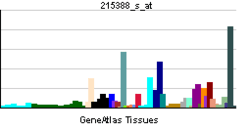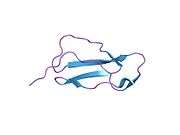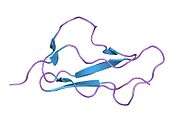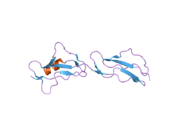Factor H
| View/Edit Human | View/Edit Mouse |
Factor H is a member of the regulators of complement activation family and is a complement control protein. It is a large (155 kilodaltons), soluble glycoprotein that circulates in human plasma (at typical concentrations of 200–300 micrograms per milliliter[4][5][6]). Its principal function is to regulate the Alternative Pathway of the complement system, ensuring that the complement system is directed towards pathogens or other dangerous material and does not damage host tissue. Factor H regulates complement activation on self cells and surfaces by possessing both cofactor activity for the Factor I mediated C3b cleavage, and decay accelerating activity against the alternative pathway C3-convertase, C3bBb. Factor H exerts its protective action on self cells and self surfaces but not on the surfaces of bacteria or viruses. This is thought to be the result of Factor H having the ability to adopt either different conformations with lower or higher activity.[7] The lower activity conformation is the predominant form in solution and is sufficient to control fluid phase amplification. The more active conformation is thought to be induced when Factor H binds to glycosaminoglycans (GAGs) and or sialic acids that are generally present on host cells but not, normally, on pathogen surfaces ensuring that self surfaces are protected whilst complement proceeds unabated on foreign surfaces.[8][9]
Structure and function
The molecule is made up of 20 complement control protein (CCP) modules (also referred to as Short Consensus Repeats or sushi domains) connected to one another by short linkers (of between three and eight amino acid residues) and arranged in an extended head to tail fashion. Each of the CCP modules consists of around 60 amino acids with four cysteine residues disulfide bonded in a 1-3 2-4 arrangement, and a hydrophobic core built around an almost invariant tryptophan residue. The CCP modules are numbered from 1-20 (from the N-terminus of the protein); CCPs 1-4 and CCPs 19-20 engage with C3b while CCPs 7 and CCPs 19-20 bind to GAGs and sialic acid.[10] To date atomic structures have been determined for CCPs 1-3,[11] CCP 5,[12] CCP 7 (both 402H & 402Y),[13] CCPs 10-11 and CCPs 11-12,[14] CCPs 12-13,[15] CCP 15, CCP 16,[16] CCPs 15-16,[17] CCPs 18-20,[18] and CCPs 19-20.[19][20] The atomic structure for CCPs 6-8 (402H) bound to the GAG mimic sucrose octasulfate,[21] CCPs 1-4 in complex with C3b[22] and CCPs 19-20 in complex with C3d (that corresponds to the thioster domain of C3b)[23][24] have also been determined. Although an atomic resolution structure for intact factor H has not yet been determined, low resolution techniques indicate that it may be bent back in solution.[25] Information available to date indicates that CCP modules 1-4 is responsible for the cofactor and decay acceleration activities of factor H, whereas self/non-self discrimination occurs predominantly through GAG binding to CCP modules 7 and/or GAG or sialic acid binding to 19-20.[25][26]
Clinical significance
Due to the central role that factor H plays in the regulation of complement, there are a number of clinical implications arising from aberrant factor H activity. Overactive factor H may result in reduced complement activity on pathogenic cells - increasing susceptibility to microbial infections. Underactive factor H may result in increased complement activity on healthy host cells - resulting in autoimmune diseases. It is not surprising therefore that mutations or single nucleotide polymorphisms (SNPs) in factor H often result in pathologies. Moreover, the complement inhibitory activities of factor H, and other complement regulators, are often used by pathogens to increase virulence.
Age-related macular degeneration
Recently it was discovered that about 35% of individuals carry an at-risk Single Nucleotide Polymorphism in one or both copies of their factor H gene. Homozygous individuals have an approximately sevenfold increased chance of developing age-related macular degeneration, while heterozygotes have a two-to-threefold increased likelihood of developing the disease. This SNP, located in CCP module 7 of factor H, has been shown to affect the interaction between factor H and heparin indicating a causal relationship between the SNP and disease.[13][27]
Deletion of two adjacent genes with a high degree of homology to complement factor H, named complement factor H-related 3 and complement factor H-related 1, protects against age-related macular degeneration because of reduced competition for binding of CFH to vascular surface binding sites.[28][29]
Schizophrenia
Alterations in the immune response are involved in pathogenesis of many neuropsychiatric disorders including schizophrenia. Recent studies indicated alterations in the complement system, including hyperactivation of the alternative complement pathway in patients with schizophrenia. It was investigated functional single nucleotide polymorphisms (SNPs) of gene encoding factor H (CFH), and found CFH rs424535 (2783-526T >A) SNP was positively associated with schizophrenia, so rs424535*A minor allele of the CFH gene may represent a risk factor for schizophrenia.[30]
Ischemic stroke
It was found that rs800292(184G >A) SNP was positively associated with stroke and rs800912 minor allele of the CFH gene might be considered as a risk factor for ischemic stroke.[30]
Atypical haemolytic uraemic syndrome
Haemolytic uraemic syndrome (HUS) is a disease associated with microangiopathic haemolytic anemia, thrombocytopenia and acute renal failure. A rare subset of this disease (referred to as atypical haemolytic uraemic syndrome, aHUS), has been strongly linked to mutations in genes of the complement system (including factor H, factor I and membrane cofactor protein), with the factor H mutations being the most numerous. These factor H mutations tend to congregate towards the C-terminus of factor H—a region responsible for discriminating self from non-self—and have been shown to disrupt heparin (a model compound for glycosaminoglycans) and C3d (equivalent to the thioester domain of C3b) binding.[31][32]
Recruitment by pathogens
Given the central role of factor H in protecting cells from complement, it is not surprising that several important human pathogens have evolved mechanisms for recruiting factor H. This recruitment of factor H by pathogens provides significant resistance to complement attack, and therefore increased virulence. Pathogens that have been shown to recruit factor H include: Aspergillus spp.; Borrelia burgdorferi; B. duttonii; B. recurrentis; Candida albicans;[33] Francisella tularensis; Haemophilus influenzae; Neisseria meningitidis; Streptococcus Pneumoniae; and Streptococcus pyogenes. The Gram-negative bacterium B.burgdorferi has five Factor H binding proteins: CRASP-1, CRASP-2, CRASP-3, CRASP-4 and CRASP-5.[34] Each CRASP protein also binds plasminogen.[34]
Interactions
Factor H has been shown to interact with Complement component 3.[35][36]
Recombinant production
Biologically active Factor H has been produced by Ralf Reski and coworkers in the moss bioreactor,[37] in a process called molecular farming. Large quantities of biologically active human Factor H, potentially suitable for therapeutic purposes, were produced using a synthetic codon-optimised gene expressed in the yeast expression host, Pichia pastoris.[38]
References
- ↑ "Diseases that are genetically associated with CFH view/edit references on wikidata".
- ↑ "Human PubMed Reference:".
- ↑ "Mouse PubMed Reference:".
- ↑ Sofat R, Mangione PP, Gallimore JR, Hakobyan S, Hughes TR, Shah T, Goodship T, D'Aiuto F, Langenberg C, Wareham N, Morgan BP, Pepys MB, Hingorani AD (April 2013). "Distribution and determinants of circulating complement factor H concentration determined by a high-throughput immunonephelometric assay". Journal of Immunological Methods. 390 (1-2): 63–73. doi:10.1016/j.jim.2013.01.009. PMID 23376722.
- ↑ Hakobyan S, Harris CL, Tortajada A, Goicochea de Jorge E, García-Layana A, Fernández-Robredo P, Rodríguez de Córdoba S, Morgan BP (May 2008). "Measurement of factor H variants in plasma using variant-specific monoclonal antibodies: application to assessing risk of age-related macular degeneration". Investigative Ophthalmology & Visual Science. 49 (5): 1983–90. doi:10.1167/iovs.07-1523. PMID 18436830.
- ↑ Scholl HP, Charbel Issa P, Walier M, Janzer S, Pollok-Kopp B, Börncke F, Fritsche LG, Chong NV, Fimmers R, Wienker T, Holz FG, Weber BH, Oppermann M (July 2008). "Systemic complement activation in age-related macular degeneration". PloS One. 3 (7): e2593. doi:10.1371/journal.pone.0002593. PMID 18596911.
- ↑ Herbert AP, Makou E, Chen ZA, Kerr H, Richards A, Rappsilber J, Barlow PN (November 2015). "Complement Evasion Mediated by Enhancement of Captured Factor H: Implications for Protection of Self-Surfaces from Complement". Journal of Immunology. 195 (10): 4986–98. doi:10.4049/jimmunol.1501388. PMC 4635569
 . PMID 26459349.
. PMID 26459349. - ↑ Pangburn MK (August 2000). "Host recognition and target differentiation by factor H, a regulator of the alternative pathway of complement". Immunopharmacology. 49 (1-2): 149–57. doi:10.1016/S0162-3109(00)80300-8. PMID 10904114.
- ↑ Rodríguez de Córdoba S, Esparza-Gordillo J, Goicoechea de Jorge E, Lopez-Trascasa M, Sánchez-Corral P (June 2004). "The human complement factor H: functional roles, genetic variations and disease associations". Molecular Immunology. 41 (4): 355–67. doi:10.1016/j.molimm.2004.02.005. PMID 15163532.
- ↑ Schmidt CQ, Herbert AP, Kavanagh D, Gandy C, Fenton CJ, Blaum BS, Lyon M, Uhrín D, Barlow PN (Aug 2008). "A new map of glycosaminoglycan and C3b binding sites on factor H". Journal of Immunology. 181 (4): 2610–9. doi:10.4049/jimmunol.181.4.2610. PMID 18684951.
- ↑ Hocking HG, Herbert AP, Kavanagh D, Soares DC, Ferreira VP, Pangburn MK, Uhrín D, Barlow PN (Apr 2008). "Structure of the N-terminal region of complement factor H and conformational implications of disease-linked sequence variations". The Journal of Biological Chemistry. 283 (14): 9475–87. doi:10.1074/jbc.M709587200. PMC 2276370
 . PMID 18252712.
. PMID 18252712. - ↑ Barlow PN, Norman DG, Steinkasserer A, Horne TJ, Pearce J, Driscoll PC, Sim RB, Campbell ID (Apr 1992). "Solution structure of the fifth repeat of factor H: a second example of the complement control protein module". Biochemistry. 31 (14): 3626–34. doi:10.1021/bi00129a011. PMID 1533152.
- 1 2 Herbert AP, Deakin JA, Schmidt CQ, Blaum BS, Egan C, Ferreira VP, Pangburn MK, Lyon M, Uhrín D, Barlow PN (Jun 2007). "Structure shows that a glycosaminoglycan and protein recognition site in factor H is perturbed by age-related macular degeneration-linked single nucleotide polymorphism". The Journal of Biological Chemistry. 282 (26): 18960–8. doi:10.1074/jbc.M609636200. PMID 17360715.
- ↑ Makou E, Mertens HD, Maciejewski M, Soares DC, Matis I, Schmidt CQ, Herbert AP, Svergun DI, Barlow PN (Dec 2012). "Solution structure of CCP modules 10-12 illuminates functional architecture of the complement regulator, factor H". Journal of Molecular Biology. 424 (5): 295–312. doi:10.1016/j.jmb.2012.09.013. PMID 23017427.
- ↑ Schmidt CQ, Herbert AP, Mertens HD, Guariento M, Soares DC, Uhrin D, Rowe AJ, Svergun DI, Barlow PN (Jan 2010). "The central portion of factor H (modules 10-15) is compact and contains a structurally deviant CCP module". Journal of Molecular Biology. 395 (1): 105–22. doi:10.1016/j.jmb.2009.10.010. PMC 2806952
 . PMID 19835885.
. PMID 19835885. - ↑ Norman DG, Barlow PN, Baron M, Day AJ, Sim RB, Campbell ID (Jun 1991). "Three-dimensional structure of a complement control protein module in solution". Journal of Molecular Biology. 219 (4): 717–25. doi:10.1016/0022-2836(91)90666-T. PMID 1829116.
- ↑ Barlow PN, Steinkasserer A, Norman DG, Kieffer B, Wiles AP, Sim RB, Campbell ID (Jul 1993). "Solution structure of a pair of complement modules by nuclear magnetic resonance". Journal of Molecular Biology. 232 (1): 268–84. doi:10.1006/jmbi.1993.1381. PMID 8331663.
- ↑ Morgan HP, Mertens HD, Guariento M, Schmidt CQ, Soares DC, Svergun DI, Herbert AP, Barlow PN, Hannan JP (2012). "Structural analysis of the C-terminal region (modules 18-20) of complement regulator factor H (FH)". PLOS ONE. 7 (2): e32187. doi:10.1371/journal.pone.0032187. PMC 3289644
 . PMID 22389686.
. PMID 22389686. - ↑ Herbert AP, Uhrín D, Lyon M, Pangburn MK, Barlow PN (Jun 2006). "Disease-associated sequence variations congregate in a polyanion recognition patch on human factor H revealed in three-dimensional structure". The Journal of Biological Chemistry. 281 (24): 16512–20. doi:10.1074/jbc.M513611200. PMID 16533809.
- ↑ Jokiranta TS, Jaakola VP, Lehtinen MJ, Pärepalo M, Meri S, Goldman A (Apr 2006). "Structure of complement factor H carboxyl-terminus reveals molecular basis of atypical haemolytic uremic syndrome". The EMBO Journal. 25 (8): 1784–94. doi:10.1038/sj.emboj.7601052. PMC 1440827
 . PMID 16601698.
. PMID 16601698. - ↑ Prosser BE, Johnson S, Roversi P, Herbert AP, Blaum BS, Tyrrell J, Jowitt TA, Clark SJ, Tarelli E, Uhrín D, Barlow PN, Sim RB, Day AJ, Lea SM (Oct 2007). "Structural basis for complement factor H linked age-related macular degeneration". The Journal of Experimental Medicine. 204 (10): 2277–83. doi:10.1084/jem.20071069. PMC 2118454
 . PMID 17893204.
. PMID 17893204. - ↑ Wu J, Wu YQ, Ricklin D, Janssen BJ, Lambris JD, Gros P (Jul 2009). "Structure of complement fragment C3b-factor H and implications for host protection by complement regulators". Nature Immunology. 10 (7): 728–33. doi:10.1038/ni.1755. PMC 2713992
 . PMID 19503104.
. PMID 19503104. - ↑ Morgan HP, Schmidt CQ, Guariento M, Blaum BS, Gillespie D, Herbert AP, Kavanagh D, Mertens HD, Svergun DI, Johansson CM, Uhrín D, Barlow PN, Hannan JP (Apr 2011). "Structural basis for engagement by complement factor H of C3b on a self surface". Nature Structural & Molecular Biology. 18 (4): 463–70. doi:10.1038/nsmb.2018. PMC 3512577
 . PMID 21317894.
. PMID 21317894. - ↑ Kajander T, Lehtinen MJ, Hyvärinen S, Bhattacharjee A, Leung E, Isenman DE, Meri S, Goldman A, Jokiranta TS (Feb 2011). "Dual interaction of factor H with C3d and glycosaminoglycans in host-nonhost discrimination by complement". Proceedings of the National Academy of Sciences of the United States of America. 108 (7): 2897–902. doi:10.1073/pnas.1017087108. PMC 3041134
 . PMID 21285368.
. PMID 21285368. - 1 2 Aslam M, Perkins SJ (Jun 2001). "Folded-back solution structure of monomeric factor H of human complement by synchrotron X-ray and neutron scattering, analytical ultracentrifugation and constrained molecular modelling". Journal of Molecular Biology. 309 (5): 1117–38. doi:10.1006/jmbi.2001.4720. PMID 11399083.
- ↑ Kirkitadze MD, Barlow PN (Apr 2001). "Structure and flexibility of the multiple domain proteins that regulate complement activation". Immunological Reviews. 180: 146–61. doi:10.1034/j.1600-065X.2001.1800113.x. PMID 11414356.
- ↑ Hageman GS, Anderson DH, Johnson LV, Hancox LS, Taiber AJ, Hardisty LI, Hageman JL, Stockman HA, Borchardt JD, Gehrs KM, Smith RJ, Silvestri G, Russell SR, Klaver CC, Barbazetto I, Chang S, Yannuzzi LA, Barile GR, Merriam JC, Smith RT, Olsh AK, Bergeron J, Zernant J, Merriam JE, Gold B, Dean M, Allikmets R (May 2005). "A common haplotype in the complement regulatory gene factor H (HF1/CFH) predisposes individuals to age-related macular degeneration". Proceedings of the National Academy of Sciences of the United States of America. 102 (20): 7227–32. doi:10.1073/pnas.0501536102. PMC 1088171
 . PMID 15870199.
. PMID 15870199. - ↑ Hughes AE, Orr N, Esfandiary H, Diaz-Torres M, Goodship T, Chakravarthy U (Oct 2006). "A common CFH haplotype, with deletion of CFHR1 and CFHR3, is associated with lower risk of age-related macular degeneration". Nature Genetics. 38 (10): 1173–7. doi:10.1038/ng1890. PMID 16998489.
- ↑ Fritsche LG, Lauer N, Hartmann A, Stippa S, Keilhauer CN, Oppermann M, Pandey MK, Köhl J, Zipfel PF, Weber BH, Skerka C (Dec 2010). "An imbalance of human complement regulatory proteins CFHR1, CFHR3 and factor H influences risk for age-related macular degeneration (AMD)". Human Molecular Genetics. 19 (23): 4694–704. doi:10.1093/hmg/ddq399. PMID 20843825.
- 1 2 Boyajyan A, Ghazaryan H, Stepanyan A, Zakharyan R (December 2013). "Genetic polymorphisms of complement factor H in schizophrenia and ischemic stroke". Mol. Immunol. 56 (3): 294. doi:10.1016/j.molimm.2013.05.154.
- ↑ Atkinson JP, Goodship TH (Jun 2007). "Complement factor H and the hemolytic uremic syndrome". The Journal of Experimental Medicine. 204 (6): 1245–8. doi:10.1084/jem.20070664. PMC 2118604
 . PMID 17548524.
. PMID 17548524. - ↑ de Jorge EG, Macor P, Paixão-Cavalcante D, Rose KL, Tedesco F, Cook HT, Botto M, Pickering MC (Jan 2011). "The development of atypical hemolytic uremic syndrome depends on complement C5". Journal of the American Society of Nephrology. 22 (1): 137–45. doi:10.1681/ASN.2010050451. PMC 3014042
 . PMID 21148255.
. PMID 21148255. - ↑ Luo S, Poltermann S, Kunert A, Rupp S, Zipfel PF (Dec 2009). "Immune evasion of the human pathogenic yeast Candida albicans: Pra1 is a Factor H, FHL-1 and plasminogen binding surface protein". Molecular Immunology. 47 (2-3): 541–50. doi:10.1016/j.molimm.2009.07.017. PMID 19850343.
- 1 2 Zipfel PF, Hallström T, Riesbeck K (Dec 2013). "Human complement control and complement evasion by pathogenic microbes--tipping the balance". Molecular Immunology. 56 (3): 152–60. doi:10.1016/j.molimm.2013.05.222. PMID 23810413.
- ↑ Soames CJ, Sim RB (Sep 1997). "Interactions between human complement components factor H, factor I and C3b". The Biochemical Journal. 326 ( Pt 2) (Pt 2): 553–61. PMC 1218704
 . PMID 9291131.
. PMID 9291131. - ↑ Jokiranta TS, Westin J, Nilsson UR, Nilsson B, Hellwage J, Löfås S, Gordon DL, Ekdahl KN, Meri S (Mar 2001). "Complement C3b interactions studied with surface plasmon resonance technique". International Immunopharmacology. 1 (3): 495–506. doi:10.1016/S1567-5769(00)00042-4. PMID 11367533.
- ↑ Büttner-Mainik A, Parsons J, Jérôme H, Hartmann A, Lamer S, Schaaf A, Schlosser A, Zipfel PF, Reski R, Decker EL (Apr 2011). "Production of biologically active recombinant human factor H in Physcomitrella". Plant Biotechnology Journal. 9 (3): 373–83. doi:10.1111/j.1467-7652.2010.00552.x. PMID 20723134.
- ↑ Schmidt CQ, Slingsby FC, Richards A, Barlow PN (Apr 2011). "Production of biologically active complement factor H in therapeutically useful quantities". Protein Expression and Purification. 76 (2): 254–63. doi:10.1016/j.pep.2010.12.002. PMID 21146613.
Further reading
- Bradley DT, Zipfel PF, Hughes AE (Jun 2011). "Complement in age-related macular degeneration: a focus on function". Eye. 25 (6): 683–93. doi:10.1038/eye.2011.37. PMC 3178140
 . PMID 21394116.
. PMID 21394116. - Kardys I, Klaver CC, Despriet DD, Bergen AA, Uitterlinden AG, Hofman A, Oostra BA, Van Duijn CM, de Jong PT, Witteman JC (Apr 2006). "A common polymorphism in the complement factor H gene is associated with increased risk of myocardial infarction: the Rotterdam Study". Journal of the American College of Cardiology. 47 (8): 1568–75. doi:10.1016/j.jacc.2005.11.076. PMID 16630992.
- Pío R, Elsasser TH, Martínez A, Cuttitta F (Apr 2002). "Identification, characterization, and physiological actions of factor H as an adrenomedullin binding protein present in human plasma". Microscopy Research and Technique. 57 (1): 23–7. doi:10.1002/jemt.10047. PMID 11921353.
- Walport MJ (Apr 2001). "Complement. First of two parts". The New England Journal of Medicine. 344 (14): 1058–66. doi:10.1056/NEJM200104053441406. PMID 11287977.
- Walport MJ (Apr 2001). "Complement. Second of two parts". The New England Journal of Medicine. 344 (15): 1140–4. doi:10.1056/NEJM200104123441506. PMID 11297706.
External links
- GeneReviews/NCBI/NIH/UW entry on Atypical Hemolytic-Uremic Syndrome
- GeneReviews/NCBI/NIH/UW entry on Dense Deposit Disease/Membranoproliferative Glomerulonephritis Type II
- OMIM entries on Atypical Hemolytic-Uremic Syndrome
- Complement Factor H at the US National Library of Medicine Medical Subject Headings (MeSH)








